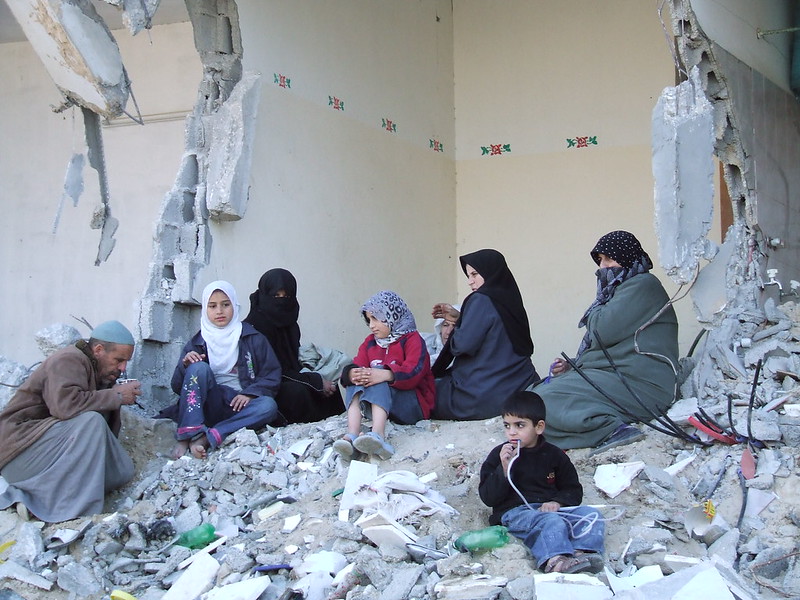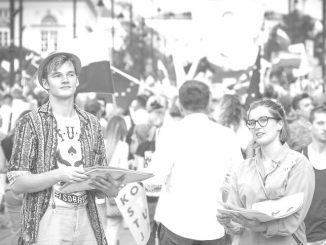A chilling report on the latest situation in Gaza, a small strip of land that has become hell on earth.
Vijay Prashad’s most recent book (with Noam Chomsky) is The Withdrawal: Iraq, Libya, Afghanistan and the Fragility of US Power (New Press, August 2022).
This article was produced by Globetrotter

On February 9, 2024, Israel’s prime minister Benjamin Netanyahu said that his army would advance into Rafah, the last remaining city in Gaza not occupied by the Israelis. Most of the 2.3 million Palestinians who live in Gaza had fled to its southern border with Egypt after being told by the Israelis on October 13, 2023, that the north had to be abandoned and that the south would be a “safe zone.” As the Palestinians from the north, particularly from Gaza City, began their march south—often on foot—they were attacked by Israeli forces, who gave them no safe passage. The Israelis said that anything south of Wadi Gaza, which divides the narrow strip, would be safe, but then as the Palestinians moved into Deir-al-Balah, Khan Younis, and Rafah, they found the Israeli jets following them and the Israeli troops coming after them. Now, Netanyahu has said that his forces will enter Rafah to combat Hamas. On February 11, Netanyahu told NBC news that Israeli would provide “safe passage for the civilian population” and that there would be no “catastrophe.”
Catastrophe
The use of the word “catastrophe” is significant. This is the accepted English translation of the word “nakba,” used since 1948 to describe the forced removal that year of half of the Palestinian population from their homes. Netanyahu’s use of the term comes after high officials of the Israeli government have already spoken of a “Gaza Nakba” or a “Second Nakba.” These phrases formed part of South Africa’s application to the International Court of Justice (ICJ) on December 29, 2023, alleging that they are part of the “expressions of genocidal intent against the Palestinian people by Israeli state officials.” A month later, the ICJ said that there was “plausible” evidence of genocide being conducted in Gaza, highlighting the words of the Israelis officials. One official, the Israeli Defense Minister Yoav Gallant said, “I have released all restraints” (quoted both by the South African complaint and in the ICJ’s order).
Netanyahu saying that there would be no “catastrophe” after over 28,000 Palestinians have been killed and after two million of the 2.3 million Palestinians in Gaza have been displaced is puzzling. Since the ICJ’s order, the Israeli army has killed nearly 2,000 Palestinians. The Israeli army has already begun to assault Rafah, a city with a population density now at 22,000 people per square kilometer. In response to the Israeli announcement that it would enter Rafah city, the Norwegian Refugee Council (NRC)—one of the few groups operating in the southern part of Gaza—said that such an invasion “could collapse the humanitarian response.” The NRC assessed nine of the shelters in Rafah, which are housing 27,400 civilians and found that the residents have no drinking water. Because the shelters are operating at 150 percent capacity, hundreds of the Palestinians are living on the street. In each of the areas that the NRC studied, they found the Palestinian refugees in the grip of hepatitis A, gastroenteritis, diarrhea, smallpox, lice, and influenza. Because of the collapse of this humanitarian response from the NRC, and from the United Nations—whose agency UNRWA has lost its funding and is under attack by the Israelis—the situation will deteriorate further.
Safe Passage
Netanyahu says that his government will provide “safe passage” to the Palestinians. These words have been heard by the Palestinians since mid-October when they were told to keep going south to prevent being killed by the Israeli bombing. Nobody believes anything that Netanyahu says. A Palestinian health worker, Saleem, told me that he cannot imagine any place of safety within Gaza. He came to Rafah’s al-Zohour neighborhood from Khan Younis, walking with his family, desperate to get out of the range of the Israeli guns. “Where do we go now?” he asks me. “We cannot enter Egypt. The border is closed. So, we cannot go south. We cannot go into Israel, because that is impossible. Are we to go north, back to Khan Younis and Gaza City?”
Saleem remembers that when he arrived in al-Zohour, the Israelis targeted the home of Dr. Omar Mohammed Harb, killing 22 Palestinians (among them five children). The house was flattened. The name of Dr. Omar Mohammed Harb stayed with me because I recalled that two years ago his daughter Abeer was to be married to Ismail Abdel-Hameed Dweik. An Israeli air strike on the Shouhada refugee camp killed Ismail. Abeer was killed in the strike on her father’s house, which had been a refuge for those fleeing from the north. Saleem moved into that area of Rafah. Now he is unsettled. “Where to go?” he asks.
Domicide
On January 29, 2024, the UN special rapporteur on the right to adequate housing, Dr. Balakrishnan Rajagopal wrote a strong essay in the New York Times called “Domicide: the Mass Destruction of Homes Should be a Crime Against Humanity.” Accompanying his article was a photo essay by Yaqeen Baker, whose house was destroyed in Jabalia (northern Gaza) by Israeli bombardment. “The destruction of homes in Gaza,” Baker wrote, “has become commonplace, and so has the sentiment, ‘The important thing is that you’re safe—everything else can be replaced.’” That is an assessment shared across Gaza amongst those who are still alive. But, as Dr. Rajagopal says, the scale of the destruction of housing in Gaza should not be taken for granted. It is a form of “domicide,” a crime against humanity.
The Israeli attack on Gaza, Dr. Rajagopal writes, is “far worse than what we saw in Dresden and Rotterdam during World War II, where about 25,000 homes were destroyed in each city.” In Gaza, he says, more than 70,000 housing units have been totally destroyed, and 290,000 partially damaged. In these three months of Israeli fire, he notes, “a shocking 60 to 70 percent of structures in Gaza, and up to 84 percent of structures in northern Gaza, have been damaged or destroyed.” Due to this domicide, there is no place for the Palestinians in Rafah to go if they go north. Their homes have been destroyed. “This crushing of Gaza as a place,” reflects Dr. Rajagopal, “erases the past, present, and future of many Palestinians.” This statement by Dr. Rajagopal is a recognition of the unfolding genocide in Gaza.
As I speak with Saleem the sound of the Israeli advance can be heard in the distance. “I don’t know when we can speak next,” he says. “I don’t know where I will be.”
Thanks to many generous donors BRAVE NEW EUROPE will be able to continue its work for the rest of 2024 in a reduced form. What we need is a long term solution. So please consider making a monthly recurring donation. It need not be a vast amount as it accumulates in the course of the year. To donate please go HERE.



Be the first to comment